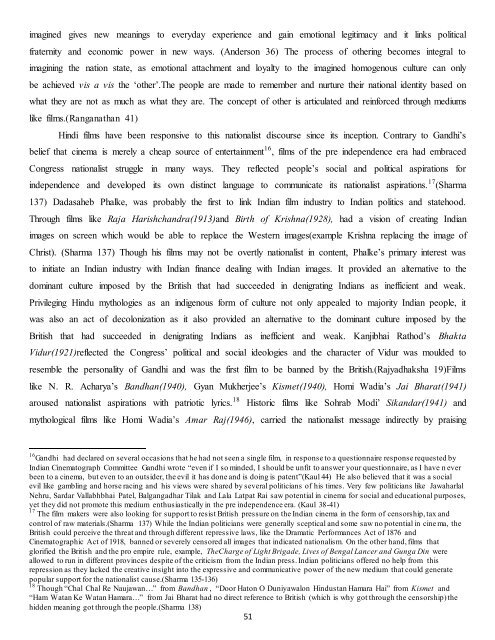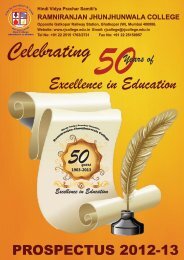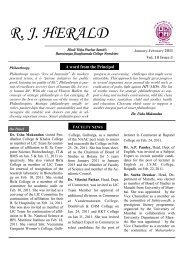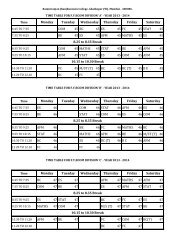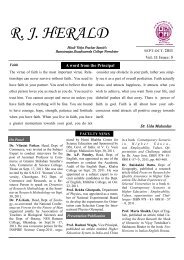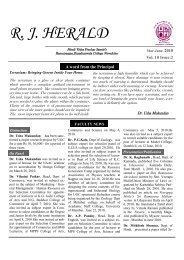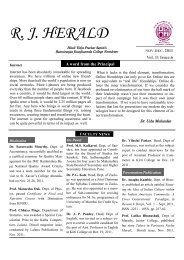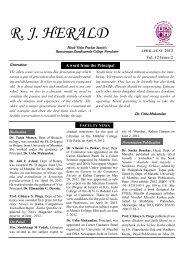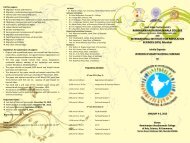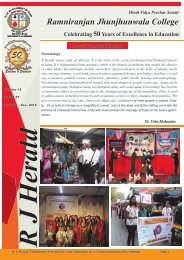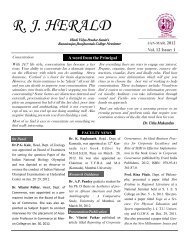ISBN 978-81-925489-2-0 - ramniranjan jhunjhunwala college
ISBN 978-81-925489-2-0 - ramniranjan jhunjhunwala college
ISBN 978-81-925489-2-0 - ramniranjan jhunjhunwala college
You also want an ePaper? Increase the reach of your titles
YUMPU automatically turns print PDFs into web optimized ePapers that Google loves.
imagined gives new meanings to everyday experience and gain emotional legitimacy and it links political<br />
fraternity and economic power in new ways. (Anderson 36) The process of othering becomes integral to<br />
imagining the nation state, as emotional attachment and loyalty to the imagined homogenous culture can only<br />
be achieved vis a vis the ‘other’.The people are made to remember and nurture their national identity based on<br />
what they are not as much as what they are. The concept of other is articulated and reinforced through mediums<br />
like films.(Ranganathan 41)<br />
Hindi films have been responsive to this nationalist discourse since its inception. Contrary to Gandhi’s<br />
belief that cinema is merely a cheap source of entertainment 16 , films of the pre independence era had embraced<br />
Congress nationalist struggle in many ways. They reflected people’s social and political aspirations for<br />
independence and developed its own distinct language to communicate its nationalist aspirations. 17 (Sharma<br />
137) Dadasaheb Phalke, was probably the first to link Indian film industry to Indian politics and statehood.<br />
Through films like Raja Harishchandra(1913)and Birth of Krishna(1928), had a vision of creating Indian<br />
images on screen which would be able to replace the Western images(example Krishna replacing the image of<br />
Christ). (Sharma 137) Though his films may not be overtly nationalist in content, Phalke’s primary interest was<br />
to initiate an Indian industry with Indian finance dealing with Indian images. It provided an alternative to the<br />
dominant culture imposed by the British that had succeeded in denigrating Indians as inefficient and weak.<br />
Privileging Hindu mythologies as an indigenous form of culture not only appealed to majority Indian people, it<br />
was also an act of decolonization as it also provided an alternative to the dominant culture imposed by the<br />
British that had succeeded in denigrating Indians as inefficient and weak. Kanjibhai Rathod’s Bhakta<br />
Vidur(1921)reflected the Congress’ political and social ideologies and the character of Vidur was moulded to<br />
resemble the personality of Gandhi and was the first film to be banned by the British.(Rajyadhaksha 19)Films<br />
like N. R. Acharya’s Bandhan(1940), Gyan Mukherjee’s Kismet(1940), Homi Wadia’s Jai Bharat(1941)<br />
aroused nationalist aspirations with patriotic lyrics. 18 Historic films like Sohrab Modi’ Sikandar(1941) and<br />
mythological films like Homi Wadia’s Amar Raj(1946), carried the nationalist message indirectly by praising<br />
16 Gandhi had declared on several occasions that he had not seen a single film, in response to a questionnaire response requested by<br />
Indian Cinematograph Committee Gandhi wrote “even if I so minded, I should be unfit to answer your questionnaire, as I have n ever<br />
been to a cinema, but even to an outsider, the evil it has done and is doing is patent”(Kaul 44) He also believed that it was a social<br />
evil like gambling and horse racing and his views were shared by several politicians of his times. Very few politicians like Jawaharlal<br />
Nehru, Sardar Vallabhbhai Patel, Balgangadhar Tilak and Lala Latpat Rai saw potential in cinema for social and educational purposes,<br />
yet they did not promote this medium enthusiastically in the pre independence era. (Kaul 38-41)<br />
17 The film makers were also looking for support to resist British pressure on the Indian cinema in the form of censorship, tax and<br />
control of raw materials.(Sharma 137) While the Indian politicians were generally sceptical and some saw no potential in cine ma, the<br />
British could perceive the threat and through different repressive laws, like the Dramatic Performances Act of 1876 and<br />
Cinematographic Act of 1918, banned or severely censored all images that indicated nationalism. On the other hand, films that<br />
glorified the British and the pro empire rule, example, TheCharge of Light Brigade, Lives of Bengal Lancer and Gunga Din were<br />
allowed to run in different provinces despite of the criticism from the Indian press. Indian politicians offered no help from this<br />
repression as they lacked the creative insight into the expressive and communicative power of the new medium that could generate<br />
popular support for the nationalist cause.(Sharma 135-136)<br />
18 Though “Chal Chal Re Naujawan…” from Bandhan , “Door Haton O Duniyawalon Hindustan Hamara Hai” from Kismet and<br />
“Ham Watan Ke Watan Hamara…” from Jai Bharat had no direct reference to British (which is why got through the censorship) the<br />
hidden meaning got through the people.(Sharma 138)<br />
51


